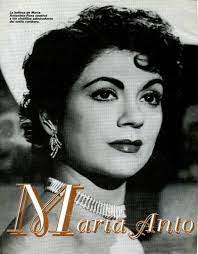MARIA ANTONIETA PONS, THE GREATEST RUMBERA IN THE CUBAN MUSICAL HISTORY. VIDEOS
Five women are considered the queens of rumba movies. They are: María Antonieta Pons, Meche Barba, Amalia Aguilar, Ninón Sevilla and Rosa Carmina. All five triumphed in Mexican cinema in the 1940s and 1950s. The journalist Fernando Muñoz Castillo in a book he wrote in 1993 called them ‘Las reinas del Tópico’. Four of them were born in Cuba.
Today we are going to refer, tell you, some history of one of the most daring, beautiful and outstanding rumberas in those years of triumphs, it was María Antonieta Pons, also a versatile actress of Mexican cinema. She was born on June 11, 1922, in Havana, Cuba.
One of “The Queens of the Tropic”, a versatile actress who worked in various film genres such as drama, comedy, musical, fantasy, romance, and “thriller”, alongside great actors such as Sara García. Thus, the Cuban, along with Ninón Sevilla, Meche Barba, Rosa Carmina, and Amalia Aguilar, was the pioneer of the so-called “rumberas del cine” and starred in numerous musical films.
ARTISTIC CAREER
She began her career in film in her homeland in 1938, after the release of the film “The Red Serpent”, starring Aníbal de Mar in the role of “Chan-Li / Po”. Later, she traveled to Mexico and during the 40s and 50s she was recognized as “The first rumbera of cinematography.”
https://youtu.be/bWPUUue8WL0
MARIA ANTONIETA PONS DANCING (VIDEOS)
The exuberant movement of the hips and shoulders took possession of the world’s screens to lead the group of rumberas, also made up of Meche Barba, Ninón Sevilla, and Rosa Carmina, nicknamed “The Queens of the Tropic.” Her career was long and successful, which she began in 1942 with “Chaflán’s Last Adventure”, in which she played the role of “La cubanita”.
María Antonieta Pons began with only three feature films in 1946 to reach the highest number of her in 1950 when 50 films of this modality were produced.
The actress appeared in six of these productions between 1947 and 1950 and was the central figure in the new version of “La Mujer del Puerto”, which Andrea Palma had made in the 1930s. She also appeared in a film made in Puerto Rico, entitled “Romance in Puerto Rico”. In addition, she played a nun and “Cleopatra” in “The intimate life of Marco Antonio and Cleopatra”, a film in which the comedian Luis Sandrini also intervenes.
At the end of the 1950s, the Mexican rumberas cinema died out. It seemed that within the new cinematographic trends there was no place for the wild eroticism of these women of fire and dangerous beauty. So some withdrew and others went on to television. They occasionally made guest appearances on the big screen.
At the end of the cabaret cycle and directed by her second husband, Ramón Pereda, Maria Antonieta ventured into ranchero and children’s productions.
https://youtu.be/pVEjsX2jyOc
MARIA ANTONIETA PONS DANCING (VIDEOS)
She performed alongside the great figures of the time such as Pedro Armendáriz, Sara García, Germán Valdés “Tin Tan”, Enrique Rambal, Blanca Estela Pavón, Manuel Dondé, Luis Aguilar and Lola Beltrán, in a career spanning nearly three decades.
THE END OF HER CAREER COMES
Her career ended in 1965 when she led the cast of “Caña Brava”, after almost 30 years of presence in Mexican cinema with an interpretive career that made her repeat that of cabaret more than any other role, in what was called “cycle of cabareteras in Mexican cinema ”.
Outstanding among his filmography is “Red Konga”, “Long live my misfortune!”, “Rosalinda”, “The queen of the tropics”, “The insatiable”, “María Cristina”, “The queen of the mambo”, “Crime theater” , “Flor canela” and “Caña brava”. As well as “One star and two starry”, “The thousand and one nights”, “Crime theater”, “West Indian charm”, “Stormy passions”, “The mysteries of the underworld”, “Bulls, love and glory” and ” Cruel fate ”.
The Cuban actress and dancer died in Mexico City on August 20, 2004, at the age of 82, leaving a legacy of her that made her the greatest rumba in history.
MARIA ANTONIETA PONS, LA MÁS GRANDE RUMBERA EN LA HISTORIA MUSICAL CUBANA. VIDEOS
Cinco mujeres están consideradas las reinas de las películas de rumberas. Ellas son: María Antonieta Pons, Meche Barba, Amalia Aguilar, Ninón Sevilla y Rosa Carmina. Las cinco triunfaron en el cine mexicano de las décadas del 40 y el 50. El periodista Fernando Muñoz Castillo en un libro que escribió en 1993 las llamó ‘Las reinas del Trópico’. Cuatro de ellas nacieron en Cuba.
Hoy nos vamos a referir, contarles, algo de historia de una de las rumberas mas atrevidas, bellas y destacadas en esos anos de triunfos, fue María Antonieta Pons.también versatil actriz del cine mexicano. Nació el 11 de junio de 1922 en La Habana, Cuba.
Una de “Las reinas del trópico”, actriz versátil que trabajó en diversos géneros fílmicos como drama, comedia, musical, fantasía, romance y “thriller”, al lado de grandes actores como Sara García. Así, la cubana, junto a Ninón Sevilla, Meche Barba, Rosa Carmina y Amalia Aguilar, fue la pionera de las llamadas “rumberas del cine” y protagonista de numerosas películas musicales.
CARRERA ARTISTICA
Inició su carrera en cine en su tierra natal, en 1938, tras el lanzamiento de la película “La serpiente roja”, protagonizada por Aníbal de Mar en el papel de “Chan-Li/Po”. Tiempo después viajó a México y durante la década de los 40 y 50 fue reconocida como “La primera rumbera de la cinematografía”.
https://youtu.be/VqpBfH6UUeM
MARIA ANTONIETA PONS (VIDEOS)
El exuberante movimiento de cadera y hombros se posesionó de las pantallas del mundo para encabezar el grupo de rumberas integrado también por Meche Barba, Ninón Sevilla y Rosa Carmina, apodadas “Las reinas del trópico”. Su trayectoria fue larga y exitosa, que inició en 1942 con “La última aventura de Chaflán”, en la que hizo el papel de “La cubanita”.
María Antonieta Pons comenzó con sólo tres largometrajes en 1946 para alcanzar su mayor número en 1950, cuando se producen 50 filmes de esta modalidad.
La actriz apareció en seis de estas producciones entre 1947 y 1950 y fue la figura central de la nueva versión de “La mujer del puerto”, que había realizado Andrea Palma en los años 30. También apareció en una película hecha en Puerto Rico, titulada “Romance en Puerto Rico”. Además, interpretó a una monja y a “Cleopatra” en “La vida íntima de Marco Antonio y Cleopatra”, filme en el que también interviene el cómico Luis Sandrini.
A finales de la década de 1950, el cine mexicano de rumberas se extinguió. Parecía que dentro de las nuevas tendencias cinematográficas no había lugar para el erotismo silvestre de estas mujeres de fuego y peligrosa belleza. Entonces, algunas se retiraron y otras pasaron a la televisión. En ocasiones hicieron apariciones especiales en la pantalla grande.
Al finalizar el ciclo cabaretero y dirigida por su segundo esposo, Ramón Pereda, Maria Antonieta incursionó en producciones rancheras e infantiles.
https://youtu.be/APe5y36NLfQ
MARIA ANTONIETA PONS (VIDEOS)
Actuó junto a las grandes figuras de la época como Pedro Armendáriz, Sara García, Germán Valdés “Tin Tan”, Enrique Rambal, Blanca Estela Pavón, Manuel Dondé, Luis Aguilar y Lola Beltrán, en una trayectoria de cerca de tres décadas.
LLEGA EL FINAL DE SU CARRERA
Su carrera concluyó en 1965 cuando encabezó el reparto de “Caña brava”, tras casi 30 años de presencia en el cine mexicano con una trayectoria interpretativa que la hizo repetir más que ningún otro papel el de cabaretera, en lo que se llamó “ciclo de las cabareteras en el cine mexicano”.
Destacan entre su filmografía “Konga roja”, “¡Viva mi desgracia!”, “Rosalinda”, “La reina del trópico”, “La insaciable”, “María Cristina”, “La reina del mambo”, “Teatro del crimen”, “Flor canela” y “Caña brava”. Así como “Una estrella y dos estrellados”, “Las mil y una noches”, “Teatro del crimen”, “Embrujo antillano”, “Pasiones tormentosas”, “Los misterios del hampa”, “Toros, amor y gloria” y “Cruel destino”.
La actriz y bailarina cubana murió en la ciudad de México el 20 de agostó de 2004 a los 82 años de edad, dejando un legado que la convirtió en la más grande rumbera de la historia.
Agencies/ Wiki/ Sarmiento/ Internet Photos/ YouTube/ www.TheCubanHistory.com
THE CUBAN HISTORY, HOLLYWOOD.



 MARIA ANTONIETA PONS, the Greatest Rumbera in the Cuban Musical History. * MARIA ANTONIETA PONS, la Más Grande Rumbera en la Historia Musical Cubana. PHOTOS/VIDEOS.
MARIA ANTONIETA PONS, the Greatest Rumbera in the Cuban Musical History. * MARIA ANTONIETA PONS, la Más Grande Rumbera en la Historia Musical Cubana. PHOTOS/VIDEOS.







